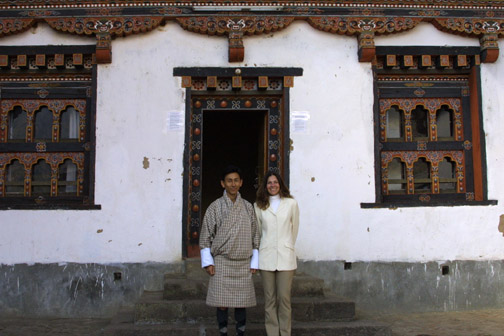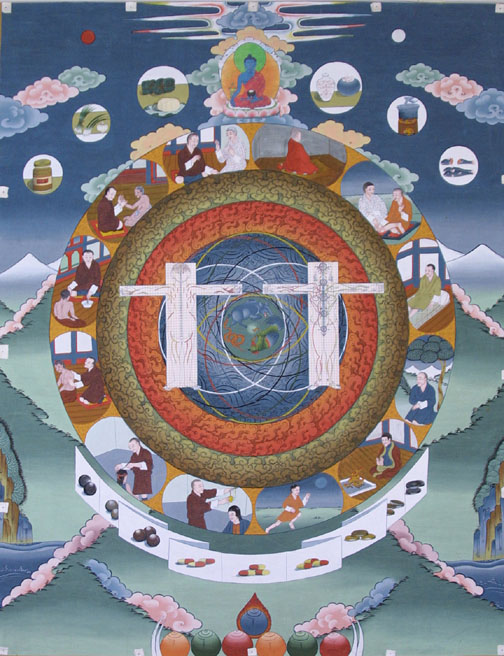|
Trip
to Traditional Medicine Institute

From the
hotel the whole group embarked in cars, jeeps or minivan. We
arrived at what ends up being a mini medicine factory, a plant
collection & tea manufacturer, and a school. Here, for me,
it felt like 'West Peeks at East' as I stepped into a very different
view of health.

The Bhutan Medical Institute teaches all things are made of
5 elements (earth, wind, air, fire, and 'space') very simular
to the Ayurveda holistic health system based on Vedic writings
of harmony with nature. Going along the lines of the Ayureda
way at looking at illness, all sickness comes from imbalance
of the three humors which in Bhutan are represented in art as
the Boar/Ignorance, the Pheasant/Greed & Lust, and the Snake/Anger
& Hate.
The tour
starts with pill polishing. Then we sorta do a flash-back by
passing by about 20 fifty-five gallon plastic drums full of
different raw herbs; buttercup, safflower, rhodedendrons, rapseed
mustard, cardamon, edelweiss, juniper, giant rhubarb, sandlewood,
etc. We continue past cubicles for identification & storage,
quarantine, purity check, steroid extridation, quality control,
measuring and dosage formulation, and a secret room full of
unrevealed tryptamine plants unknow elsewhere.
The need
to standardize dosages is the hearld of pills, capsules and
tablets. The old powders had built in human error potentials
and as well as a shorter shelf life. The United Nations, Europe
and India are the key players in Bhutan providing equipment
in 1998. Part of the deal was that Bhutan would unveil some
of it's secret ritual herbs, which apparently they did in 2000.
However, we were told that there are many many more still unshared.
More
Secrets
Since you can't patent herbal remedies the Medical Institute
of Bhutan has a division for the methodolgy of extractions.
There are 123 people working in the plant collection & tea
producing part of the Medical Institute, 70 in the medicine
making part.
Base
3
There are over 600 plants used in Bhutanese herbal cures (some
say up to 3000) but I was most interested in the three that
form the base of all of them.
1-Terminalia
Chebula know by the Tibetans as "the King of Herbs"
it is from a fruit on a big tree. It nourishes the brain and
nerves. more
info
2-Nuts on
another big tree give Terminalia Belerica, another of
the famous myrabolan fruits of Ayurveda. It excels at removing
stones and accumulations of toxins (mucus, cholesterol, mineral
deposits) in the digestive, urinary, and respiratory tracts.
3- Ironically
the Museum section of the Institute did not have a visual of
the third ingredient (and hence I couldn't copy down the name),
but they told me it comes from the fruits of a very common small
shrub - chi?/Juria? - which are sweet and sour with lots of
vitamin C.
Treatment
Each village has it's local shaman but obviously Bhutan is incorporating
modernizations. The Medical Institue has just recently become
a viable training center. Right now there are 6 men training
as doctors at the institute, which is a 6 year program. Next
year there will be 23. The institue has been gathering herbs
from the wild, but currently there are only two guys who do
this and so locals are employed, mostly yak herders. There has
been lots of recent encouragement of farming plants, especially
rare and endangered species. Medicine and treatment is free
to Bhutan citizens but western style remedies are imported for
hospital use only and typical western pharmacuticals are not
sold on the streets.
Questions
They asked us if we wanted to be examined? It would be free.
"Please save your morning pee and bring it in when you
come to do the exam" we are told. I can only regret that
I did not feel I had any ailment worthy of the offer. An exam
in Bhutan, after urine analysis, is started with inquiries into
your lifestyle that, amoung other things, include questions
of diet, exercise, temperment, dreams and libido activity. Your
astrology is observed, your palms are read.
Depending
on what is wrong with you, you might be told to go to a cold
climate and sit with friends, or stay inside in warmth near
fire, etc. Massage is also a form of cure, as is meditation,
so is blood-letting and accupuncture. The Bhutanese have their
own form of accupuncture. They only use gold or silver needles
and (if I understood right) they don't actually prick the skin.
Performing rituals was not talked about, but then I didn't think
to ask.
Tea
The institute sells it's own tea. It's their first commercial
product. I bought 3 packages. They said it has two ingredients,
Safflower and Cinnamin, and is best for digestion but like all
herbal fixes, it works best when used over a long period. Safflower
is good for the liver, cinnamin is a general tonic but here
with Safflower it is espcially good for high blood pressue.
Saving
the ‘Valley of Medicinal Herbs’
I am told it is recorded since ancient times in historical
records that the Kingdom of Bhutan has been well known for its
herbs. All of the tourism websites claim "For centuries,
Bhutanese have treasured the natural environment and have looked
upon it as the source of all life." This really piqued
my interest. What exactly is the Bhutanese idea of the source
of life? I can't help but wonder about that on a more metaphysical
level given the potential properties of some plants. Bhutan
is practically a Bio-Zone and the government has managed to
retain over 70% of it's forests but they see their success at
preserving the land also a cause for concern. They say, "As
time goes on controlling poachers will become a problem."I
don't think they are thinking only of timber.
|